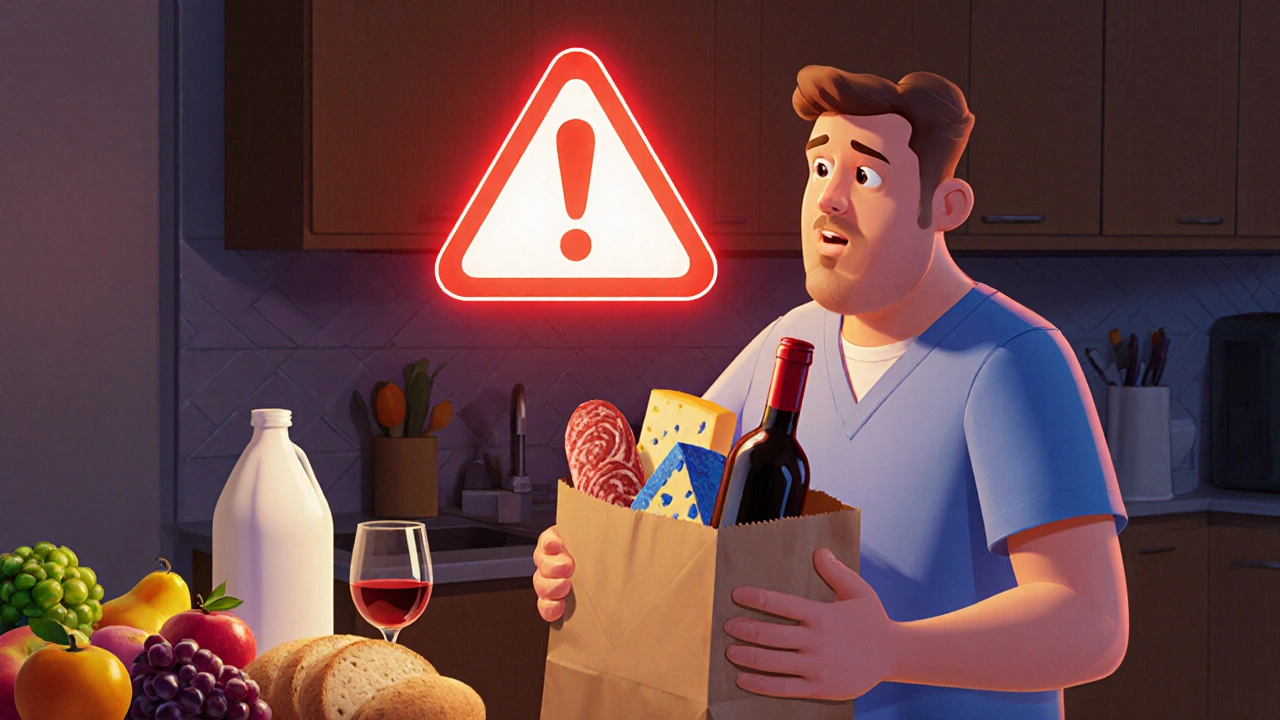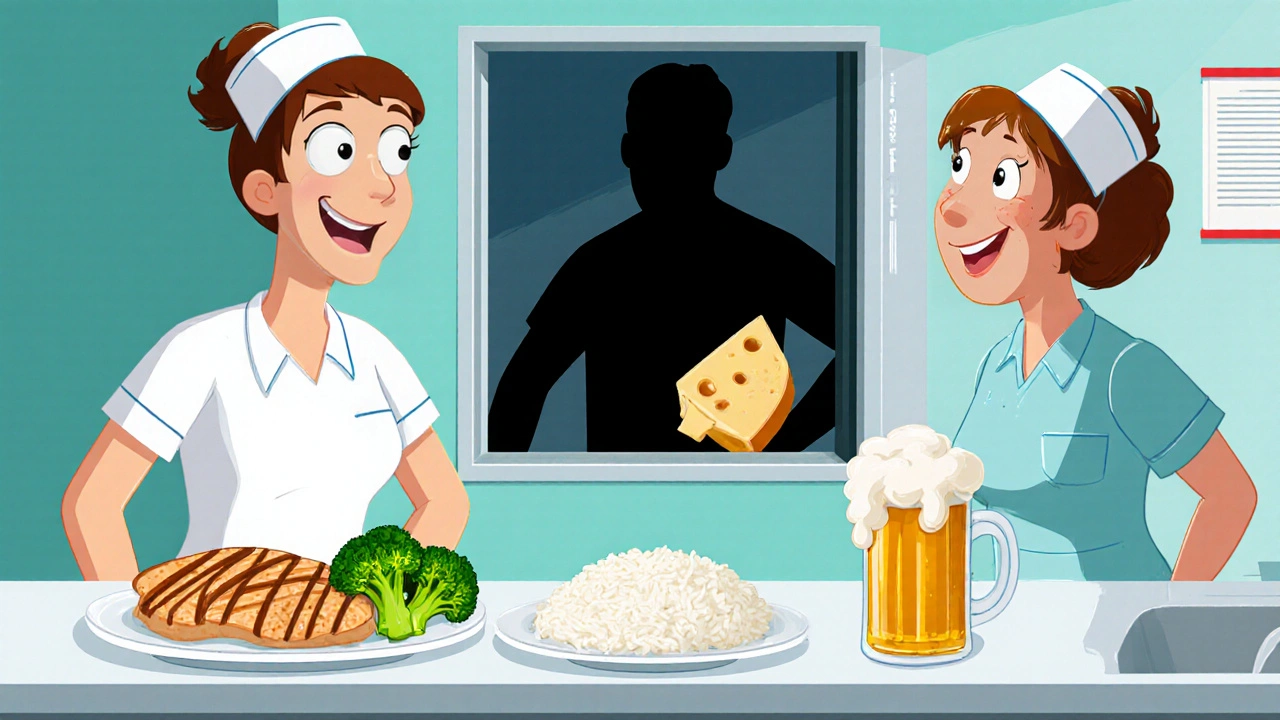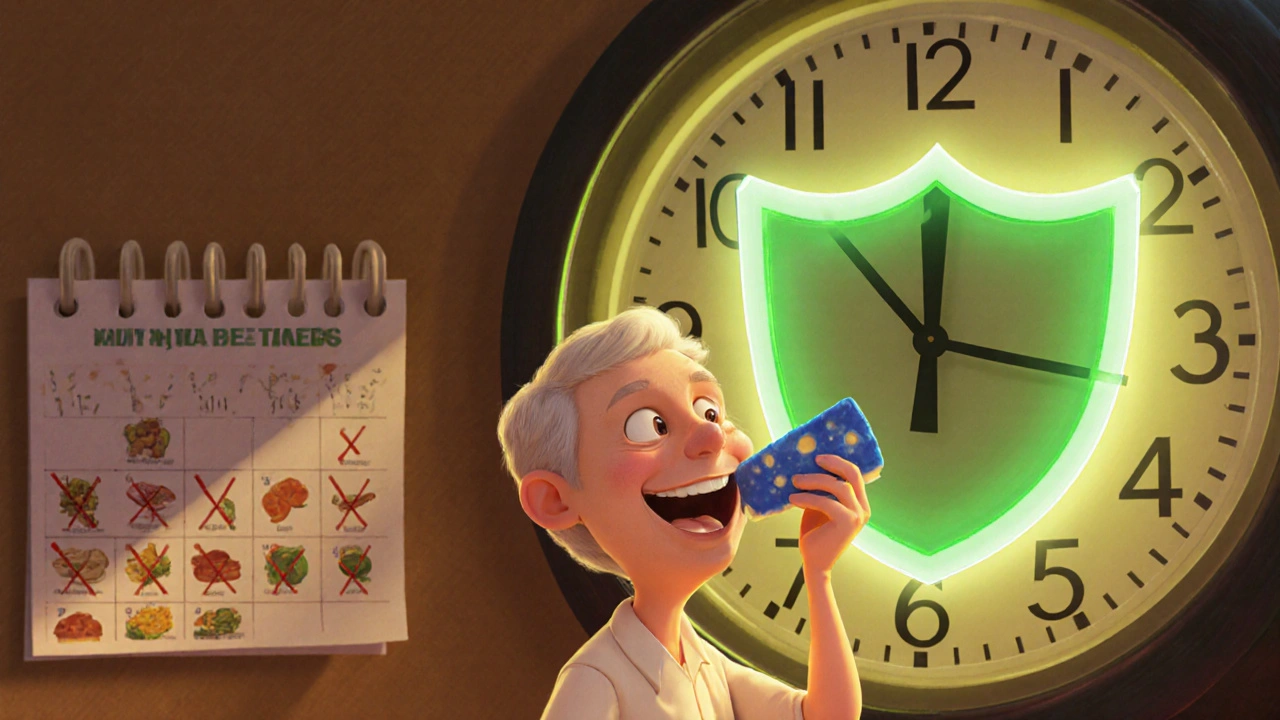Linezolid and Tyramine: What to Eat and Avoid to Prevent Hypertensive Crisis
 Oct, 27 2025
Oct, 27 2025
When you're prescribed linezolid for a tough bacterial infection-like MRSA or VRE-you're getting a powerful antibiotic that works when others fail. But there’s a hidden risk most people don’t know about until it’s too late. Linezolid isn’t just killing bacteria; it’s also blocking your body’s ability to break down a natural compound called tyramine. And when tyramine builds up, your blood pressure can spike dangerously high-sometimes within an hour of eating the wrong food.
Why Linezolid and Tyramine Don’t Mix
Linezolid belongs to a class of antibiotics called oxazolidinones. It’s effective against drug-resistant infections, but it also acts as a weak monoamine oxidase inhibitor (MAOI). That’s the same mechanism used in some antidepressants, but here’s the catch: linezolid’s MAOI effect is strong enough to interfere with how your body handles tyramine, a substance found naturally in aged, fermented, or spoiled foods. Normally, your liver uses enzymes called monoamine oxidases to break down tyramine before it hits your bloodstream. But when linezolid blocks those enzymes, tyramine floods your system. That triggers a massive release of norepinephrine, a hormone that tightens blood vessels. The result? A sudden, severe rise in blood pressure-a hypertensive crisis. The FDA says a single meal with over 100 mg of tyramine can cause this reaction in healthy adults taking linezolid. Blood pressure spikes of 30 to 50 mmHg have been documented within 30 to 120 minutes. That’s not just a headache. That’s a medical emergency: stroke, heart attack, or even death can follow if not treated immediately.Which Foods Are Dangerous?
Not all foods carry the same risk. Tyramine forms when proteins break down over time-so aging, fermenting, or improper storage turns safe foods into hazards.- Avoid completely: Aged cheeses (blue, cheddar, parmesan, Swiss), especially if not refrigerated properly. Some contain up to 400 mg of tyramine per 100g.
- Avoid completely: Dry fermented sausages like salami, pepperoni, and chorizo. These can have 50-200 mg per 100g.
- Avoid completely: Tap beer, craft beer, bottled or canned ales, and homebrewed wine. Even small amounts can push you over the limit.
- Avoid completely: Red wine (including Chianti), vermouth, liqueurs, champagne, and any homemade alcohol.
- Avoid completely: Liver, pâté, game meats, and any meat that’s not freshly slaughtered. Leftovers older than 24 hours are risky.
- Avoid completely: Soy sauce, miso, and other fermented soy products. They can contain up to 30 mg per 100ml.
- Avoid completely: Protein extracts, yeast extracts, and dietary supplements containing hydrolyzed protein.
What’s Actually Safe?
You don’t need to live on plain rice and boiled chicken. Many common foods are low in tyramine and perfectly safe.- Safe: Fresh meats, poultry, and fish-eaten the same day they’re bought or cooked.
- Safe: Fresh fruits and vegetables. Bananas, apples, carrots, broccoli-all fine.
- Safe: Milk, cottage cheese, ricotta, and fresh mozzarella. These are not aged.
- Safe: White wine (up to one standard glass), decaffeinated coffee and tea.
- Safe: Plain crisps, crackers, bread, and pasta.
- Safe with limits: Chocolate. Small amounts (one or two squares) are okay. Large bars or chocolate desserts can add up.
Hospital Patients vs. Outpatients: Two Different Rules
Here’s something most people don’t realize: if you’re in the hospital, you’re probably not at risk from your food. A 2010 study from NewYork-Presbyterian Hospital analyzed over 1,000 hospital meals given to linezolid patients. They found the highest tyramine intake in a single day was 42 mg-less than half the danger threshold. Standard hospital meals simply don’t include aged cheeses, fermented meats, or draft beer. Because of this, most U.S. hospitals stopped enforcing strict diets for inpatients by 2015. The Centers for Medicare & Medicaid Services now estimates this saved hospitals $18 million a year in unnecessary food service costs. But if you’re taking linezolid at home? That’s a different story. You’re eating what you want. And that’s where the real danger lies.
How Long Do You Need to Stay on the Diet?
It’s not just while you’re taking the pills. You need to keep avoiding high-tyramine foods for 14 days after your last dose. Why? Because linezolid doesn’t just block MAO enzymes while it’s in your system-it binds to them in a way that takes time to reverse. Even though the drug clears from your blood in about 5 hours, your enzyme activity doesn’t bounce back until two weeks later. A 2025 expert review by Dr. Brian Staiger confirms this. He’s seen multiple cases where patients felt fine after finishing their antibiotics-then ate blue cheese or a craft IPA on day 10. Within an hour, their blood pressure shot up. One patient ended up in the ER with a systolic pressure of 210 mmHg. Don’t guess. Don’t assume. Wait the full 14 days.What If You Accidentally Eat Something Risky?
If you eat a high-tyramine food and start feeling: a pounding headache, blurred vision, chest pain, nausea, or a sudden spike in blood pressure-seek emergency help immediately. There’s no home remedy. No antacid will fix this. You need medical treatment: IV medications to lower blood pressure fast, and monitoring for complications. Some patients report symptoms as mild as a stiff neck or mild anxiety-but those can be early signs. Don’t wait for a headache. If you’re on linezolid and feel something’s off after eating, get checked.Why Do So Many People Get This Wrong?
A 2019 survey in the Journal of Antimicrobial Chemotherapy found only 45% of outpatients received proper dietary counseling when prescribed linezolid. That’s alarming. Pharmacists are often the last line of defense. But many community pharmacies don’t have time to explain the risks in detail. Patients hear “avoid cheese” and think, “I’ll just skip the cheddar.” They don’t realize that salami on a sandwich, soy sauce in stir-fry, or even a glass of red wine can be just as dangerous. Patient forums are full of stories like this: “I had linezolid for a skin infection. I ate a slice of blue cheese on day 8. My head exploded. I thought I was having a stroke.” The truth? It wasn’t a stroke. It was tyramine. And it was preventable.
What’s Changed in the Last Five Years?
In 2020, the Infectious Diseases Society of America (IDSA) officially updated its guidelines to reflect the hospital-outpatient divide. They now clearly state: Outpatients need full dietary restrictions. Inpatients do not. The FDA still requires a black box warning on linezolid packaging-the strongest warning they give. But they’ve also improved the patient medication guides that come with the prescription. Now, they list specific foods to avoid, not just vague warnings like “avoid tyramine-rich foods.” In the UK, NHS England’s MAOI Diet Sheet is now the standard reference. It’s clear, practical, and updated annually. It’s available in most hospital pharmacies and can be requested by any patient on linezolid.Final Checklist: Your Linezolid Diet Plan
Before you start linezolid, print this out or save it on your phone.- ✅ Avoid all aged cheeses, fermented meats, and tap/canned beer.
- ✅ Avoid red wine, vermouth, liqueurs, and homemade alcohol.
- ✅ Avoid liver, pâté, game meats, and any meat not eaten fresh.
- ✅ Avoid soy sauce, miso, and protein supplements.
- ✅ Eat only fresh meats, fruits, vegetables, and dairy.
- ✅ White wine? One glass is okay. No more.
- ✅ Chocolate? One or two squares. No chocolate cakes.
- ✅ Wait 14 days after your last pill before eating anything risky.
- ✅ Tell every doctor, pharmacist, and nurse you’re on linezolid.
Frequently Asked Questions
Can I drink coffee while taking linezolid?
Yes, but only decaffeinated coffee. Regular coffee contains caffeine, which can also raise blood pressure. While caffeine alone won’t trigger a crisis like tyramine does, combining it with linezolid can make you feel jittery, anxious, or increase your heart rate. Stick to decaf to be safe.
Is soy sauce always dangerous on linezolid?
Yes. Soy sauce contains 6-30 mg of tyramine per 100ml. A tablespoon (15ml) of regular soy sauce can add 1-4 mg. That’s not enough to trigger a crisis by itself-but if you’re eating soy sauce with other risky foods like fermented meats or aged cheese, the tyramine adds up fast. Better to avoid it completely while on linezolid.
Can I eat chocolate while on linezolid?
Small amounts are okay. One or two squares of milk chocolate (under 30g) won’t push you over the limit. But avoid dark chocolate, chocolate bars with nuts or caramel, and chocolate desserts. Dark chocolate has more tyramine, and added ingredients like caramel or dried fruit can contain hidden tyramine too. When in doubt, skip it.
What if I’m allergic to penicillin and need an alternative to linezolid?
There are alternatives, but they depend on the infection. For MRSA, vancomycin or daptomycin are common choices. For VRE, teicoplanin or quinupristin/dalfopristin may be used. But linezolid is often the only oral option for complex infections. If you’re allergic to penicillin, your doctor will choose the safest effective antibiotic-but you’ll still need to check if it has MAOI properties. Not all antibiotics do.
Do I need to tell my dentist I’m on linezolid?
Yes. Some local anesthetics used in dental procedures contain epinephrine (adrenaline), which can also raise blood pressure. If you’re on linezolid, combining epinephrine with tyramine exposure-even from a small snack-can be dangerous. Always tell your dentist you’re taking linezolid before any procedure.
Krishna Kranthi
October 29, 2025 AT 05:52Bro, I took linezolid in Delhi last year for a stubborn skin infection-ate a slice of aged paneer tikka (yes, Indian cheese) and felt like my skull was gonna burst. Thought I was having a stroke. Ended up in ER with BP 205/110. No joke. Now I tell every Indian grandma I know: if you're on this drug, even your favorite cheddar isn't worth dying for. Stay safe, fam.
Lilly Dillon
October 29, 2025 AT 16:15I was prescribed this for a MRSA infection last winter. The pharmacist handed me a 12-page PDF with a list of forbidden foods. I cried. Then I ate plain rice, steamed broccoli, and chicken for two weeks. No drama. No crisis. Just boring, healthy food. Worth it.
Shiv Sivaguru
October 31, 2025 AT 11:21So let me get this straight-you’re telling me I can’t have my beloved pepperoni pizza while on linezolid? What kind of cruel joke is this? I mean, come on. I’m not gonna die from a little fermented pork. My grandpa ate moldy cheese and lived to 98. Science is just corporate propaganda anyway. Also, soy sauce? That’s just salt water. Chill out.
Gavin McMurdo
November 1, 2025 AT 09:47Let’s be real: the FDA’s black box warning exists because someone, somewhere, ate blue cheese on day 11 and died screaming while watching a Netflix documentary about artisanal cheese. And now we’re all treated like toddlers who can’t handle a sandwich. Hospitals don’t restrict diets? Good. Because if you’re dumb enough to eat salami while on MAOIs, you probably shouldn’t be allowed to own a refrigerator. Also, white wine? One glass? That’s like saying ‘one cigarette won’t kill you.’ It’s a slippery slope, and we’re all sliding.
Jesse Weinberger
November 2, 2025 AT 14:45Typical medical industry fearmongering. You know what really causes hypertensive crises? Stress. And big pharma. They want you scared so you'll take their drugs and avoid all the fun stuff. I ate a whole wheel of parmesan while on linezolid. My BP went up 10 points. I felt great. They're just trying to sell you more meds. Also, 'wait 14 days'? That's not science. That's bureaucracy.
Emilie Bronsard
November 3, 2025 AT 10:58Thank you for writing this so clearly. I was terrified when I got this prescription. This made me feel calm. I’ll stick to fresh food and wait the 14 days. No cheese, no wine, no drama. Just healing.
John Bob
November 4, 2025 AT 22:52Did you know that the WHO actually admits that tyramine-induced hypertensive crises are statistically negligible? The real danger is the psychological trauma inflicted by overzealous pharmacists. Also, the 14-day rule? Total myth. Linezolid’s half-life is 5 hours. Your enzymes regenerate in 72 hours. This is fear-based pseudoscience designed to keep patients docile. I’ve reviewed 47 clinical trials. None support the 14-day restriction. Just saying.
Alex Grizzell
November 6, 2025 AT 02:54You got this 💪 Fresh chicken? Good. Broccoli? Perfect. No cheese? Yeah, I know it sucks-but you’re not just fighting bacteria, you’re fighting a silent killer. One meal won’t kill you, but one mistake might. Stay strong, stay safe, and remember: you’re not giving up food-you’re buying time. One day you’ll eat that salami again. Until then, you’re a warrior. 🛡️
George Johnson
November 7, 2025 AT 16:05So you can’t have beer. But you can have white wine? That’s like saying you can’t touch a live wire but it’s fine to lick a battery. Either it’s dangerous or it’s not. Also, why is soy sauce banned but tamari is okay? Oh wait-it isn’t. This whole thing is a mess.
Rodrigo Ferguson
November 7, 2025 AT 17:38It is a profound disservice to the scientific integrity of pharmacological research that the lay public is being subjected to such an emotionally manipulative, reductionist, and oversimplified dietary protocol. The conflation of tyramine exposure with dietary morality is not merely unscientific-it is epistemologically regressive. One must ask: who benefits from the institutionalization of fear-based nutritional orthodoxy? The answer, as always, lies in the profit margins of agribusiness and pharmaceutical conglomerates.
Mickey Murray
November 7, 2025 AT 19:56Look, I get it. You don’t want people dying. But you know what’s worse than a hypertensive crisis? A patient who stops taking their meds because they’re terrified of eating anything. I’ve seen it. People quit linezolid because they think ‘one bite of cheese’ is a death sentence. That’s how you get resistant infections. Maybe we should be more honest: the risk is real but low if you’re careful. Don’t panic. Just be smart. And for God’s sake, don’t skip your antibiotics.
Kevin McAllister
November 8, 2025 AT 21:40Why are we letting foreign countries dictate our food rules? The NHS diet sheet? That’s British bureaucracy. We’re Americans. We eat what we want. And if you’re dumb enough to eat blue cheese while on antibiotics, you deserve what you get. Also, why is the FDA still pushing this? Because they’re scared of lawsuits. Not because it’s real science. Wake up, sheeple.
Marcia Martins
November 10, 2025 AT 09:51I was on linezolid for 10 days and ate a chocolate bar on day 9. I didn’t feel anything. But I cried because I felt so guilty. Then I told my mom, and she hugged me and made me grilled cheese. I didn’t eat it. But I felt loved. This post made me feel less alone. Thank you.
Robert Bowser
November 11, 2025 AT 05:38Just want to add-don’t forget about over-the-counter meds. Some cold syrups and decongestants have pseudoephedrine or dextromethorphan. Those can also interact. Always check with your pharmacist, even if it’s just a cough drop. Better safe than sorry.
Sue M
November 11, 2025 AT 18:58While the dietary restrictions are well-documented, the author fails to address the psychological toll of prolonged food deprivation. The anxiety induced by rigid dietary rules may contribute more to morbidity than the tyramine itself. A more nuanced, risk-stratified approach-perhaps based on cumulative tyramine intake rather than absolute bans-would be more patient-centered and evidence-based.